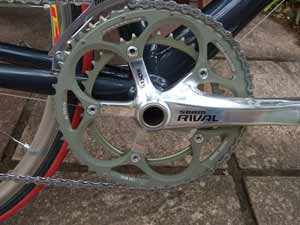 Aluminium cranks for Rival groupset |
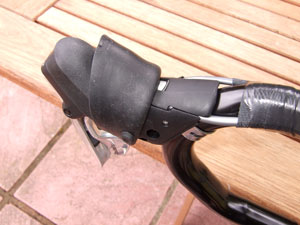 Neat route for both control cables |
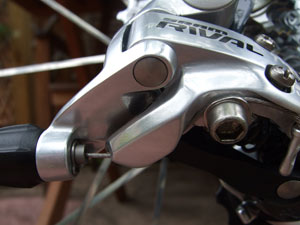 Tidy derailleur wire finishing |
 C-section crank has integral axle |
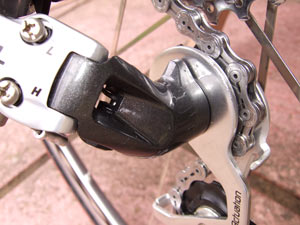 Plastic lower pivot housing and co-axial jockey wheel |
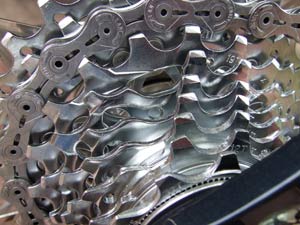 Missing sprocket teeth improve shift |
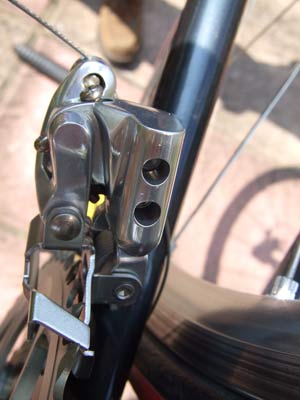 Twin fixing bolts allow fitment flexibility |
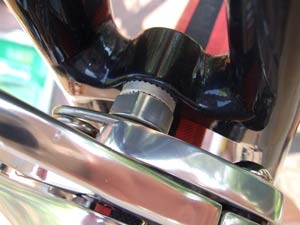 12mm flats for caliper centring |
SRAM Rival groupset £665 (inc. chain, cassette, crankset, BB, brake calipers, derailleur mechs, dual control levers)
The reception accorded SRAM’s two road groupsets when they were unveiled to the cycling world a year ago was generally enthusiastic. Since then there has been one minor upset, in the shape of a problem with the top-level Force gruppo’s brake calipers that required a recall. Otherwise, the buzz of excitement that greeted the arrival of a genuine competitor for Shimano and Campagnolo has remained steady, albeit for some time muted, thanks to the sheer difficulty of getting hold of the hardware.
The salient features are the same for both the Force and ‘budget’ Rival groupsets; the latter is reviewed here. Both feature SRAM’s novel ‘Double Tap’ dual-control shifters and boast dual-pivot brake calipers, a crankset with oversized axle and external bottom bracket bearings and neatly-styled front and rear derailleur mechanisms, the latter relying on an ‘Exact Actuation’ cable pull ratio said to minimise the effects of sticking cables, maladjustment and even the shift-spoiling effect of a too-wide derailleur hanger.
There’s nothing like completing a build, however, to give a real insight into the pros and cons of a piece of equipment, and SRAM’s Rival group is no exception. We used it to build up an Eddy Merckx Premium frameset with Mavic Ksyrium Elite wheels. First up, the bottom bracket bearing housings can be turned using Shimano’s tool, but the outer diameter of the SRAM housing is significantly smaller, so the splines are shallower. This means they mark more easily. The crankset, by Truvativ, uses forged aluminium crank arms with a ‘C’ cross section that saves some weight compared to a solid section, but at the cost of some loss of stiffness.
The axle, integral with the right-hand crank arm, has a shoulder that butts against the inside of the non-drive bearing. The left-hand crank tightens against the outside of the bearing, thus locking the axle in position. The right-hand bearing therefore does not have to resist axial loads, and should in theory last longer than the equivalent Shimano design.
The left-hand crank sits on a splined axle end similar to ISIS-Drive, and is tightened by a large retained aluminium bolt with 8mm Allen socket. This allows quick removal, but the system appears prone to loosening, with consequent possible loss of the crank. Frequent checks on crank bolt tightness are recommended.
The brake calipers have a fine appearance helped by the braced ‘Y’ arm, which is similar in concept to caliper arms by Mavic (recently) and Shimano (early Dura-Ace). The finish is excellent, although its durability in British winter conditions has yet to be proven. Small details, such as the fact that the inner wire clamp bolt has a washer under the head, are reassuring. The cable adjusters are robust and easy to turn. Spherical seatings allow perfect adjustment of the brake block cartridge shoes. There is no centring screw, this task being done using a 12mm open-ended spanner on the brake bolt. Fine in the workshop, this is not so wonderful out on the road and in any case lacks the precision of a screw.
The all-steel 10-speed cassette is shared with the Force group. It is compatible with Shimano 10-speed spacing and the Japanese company’s freehub spline pattern. The three largest sprockets are carried on an aluminium spider. The smallest six have one tooth missing; called Open Glide technology, this is said to improve shifting. Sprocket combinations are 11-26, 11-23 and 12-26. Each cassette comes installed in a neat plastic reuseable spigot, and can be simply slid onto the freehub body in one go.
Three 10-speed ‘PowerChains’ are available at different levels of weight and finish (and price; Rival price includes PC1070 chain). All use the same one-use PowerLock link. To replace the chain, it must be split elsewhere and a new link fitted. Two are supplied with the chain.
The front derailleur is designed to work happily with both standard and compact chainring combos. It is also shaped so that trimming to keep the chain from rubbing is unnecessary. The ‘braze-on’ version incorporates the neat feature of two threaded holes for the fixing bolt, ensuring that it can be used with both chainring formats on the same braze-on lug.
At the back, the mech looks outwardly much the same as the opposition. However, the lower pivot is co-axial with the top jockey wheel, requiring a longer arm to take up chain slack, and there is no spring in the upper pivot. The lower pivot housing is moulded plastic with a grey metallic finish that looks either super-light or a bit cheap depending on your viewpoint. Cable installation is easy, with finishing aided by the neat routing of the excess length. The same cable adjuster used on the brakes is, as there, both robust and easy to use. On both front and rear mechs, throw adjustment is simplicity itself thanks to well-positioned throw screws.
SRAM’s piece de resistance, or course, is the DoubleTap dual control shift system. Requiring fewer parts than the competition from either Japan or Italy, SRAM’s design is not only lighter, but smaller and easier to hide inside the lever perch. The result is a lever design that brings to mind the best features of both Shimano and Campagnolo’s designs; more slender around the middle than the latter, it is sleeker than Dura-Ace above the lever. Importantly, both cables lie under the handlebar tape for that unencumbered look.
Brake cable installation is quick and simple, with a very neat route into the lever. The gear inner wire is already installed in the lever as supplied, but looks easy to replace by removing a side panel. Both Force and Rival levers weigh the same, the use of carbon fibre for the Force brake lever allowing SRAM to ask a price premium for no practical advantage. Incidentally, the weight difference between equivalent components in the two groups is minimal, with the exception of the crankset.
It all goes together easily, with almost no opportunity for messing things up. How does it ride?
On the basis of a spin around the block, very well indeed. Given the very different way the shifters work, this is highly impressive. Basically, the brake lever does the braking, while the secondary lever shifts both up and down. At the right hand, one click ‘releases’ the ratchet mechanism. Letting the lever return makes a single shift to a higher gear. If at this point, instead of releasing the lever the rider continues to push it to a second (or more) click, it will not shift to a higher gear. Instead, it makes a single or multiple shift to a lower gear. Trying is believing, for sure.
There are concerns, such as the fact that an attempt to shift to a lower gear while in the lowest ratio will probably leave the rider in one gear higher, which is definitely not the idea, but otherwise it is as good as it sounds, and remarkably quick to learn. The front shift, however, is less satisfactory. One click while on the big ring sends the chain straight to the small one. Try a reassuring press against the lever to check you are in the big ring, and this is what happens. Also, the lack of a trim function means that the front mech must be adjusted with pin point accuracy. Surely it should be possible for SRAM, and Shimano for that matter, to make a left-hand shift mechanism with multiple positions as on the other side, giving a useful degree of trim? Campagnolo, of course, had this very feature until 2007, when it was abandoned on all except the Record QS system. If it is still found on Record, it must be a desirable option…
The brakes give firm, even and smooth retardation in the dry. Since the pads are formulated for wet and dry conditions, it is reasonable to expect the same when it rains. We shall see. Overall, then, a solid performer with a genuine performance edge over the opposition, albeit one that carries one or two potential drawbacks when shifting. Does greater familiarity help? More on RCUK when we decide for sure.

